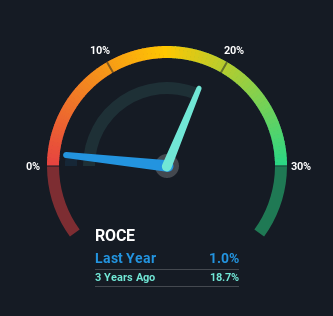Capital Allocation Trends At Bombay Dyeing and Manufacturing (NSE:BOMDYEING) Aren't Ideal
When it comes to investing, there are some useful financial metrics that can warn us when a business is potentially in trouble. When we see a declining return on capital employed (ROCE) in conjunction with a declining base of capital employed, that's often how a mature business shows signs of aging. This indicates to us that the business is not only shrinking the size of its net assets, but its returns are falling as well. So after we looked into Bombay Dyeing and Manufacturing (NSE:BOMDYEING), the trends above didn't look too great.
Understanding Return On Capital Employed (ROCE)
Just to clarify if you're unsure, ROCE is a metric for evaluating how much pre-tax income (in percentage terms) a company earns on the capital invested in its business. Analysts use this formula to calculate it for Bombay Dyeing and Manufacturing:
Return on Capital Employed = Earnings Before Interest and Tax (EBIT) ÷ (Total Assets - Current Liabilities)
0.01 = ₹241m ÷ (₹46b - ₹23b) (Based on the trailing twelve months to March 2021).
Therefore, Bombay Dyeing and Manufacturing has an ROCE of 1.0%. In absolute terms, that's a low return and it also under-performs the Luxury industry average of 9.5%.
See our latest analysis for Bombay Dyeing and Manufacturing

While the past is not representative of the future, it can be helpful to know how a company has performed historically, which is why we have this chart above. If you're interested in investigating Bombay Dyeing and Manufacturing's past further, check out this free graph of past earnings, revenue and cash flow.
What Does the ROCE Trend For Bombay Dyeing and Manufacturing Tell Us?
There is reason to be cautious about Bombay Dyeing and Manufacturing, given the returns are trending downwards. To be more specific, the ROCE was 6.1% five years ago, but since then it has dropped noticeably. And on the capital employed front, the business is utilizing roughly the same amount of capital as it was back then. This combination can be indicative of a mature business that still has areas to deploy capital, but the returns received aren't as high due potentially to new competition or smaller margins. If these trends continue, we wouldn't expect Bombay Dyeing and Manufacturing to turn into a multi-bagger.
On a side note, Bombay Dyeing and Manufacturing's current liabilities are still rather high at 50% of total assets. This can bring about some risks because the company is basically operating with a rather large reliance on its suppliers or other sorts of short-term creditors. While it's not necessarily a bad thing, it can be beneficial if this ratio is lower.
The Bottom Line On Bombay Dyeing and Manufacturing's ROCE
In the end, the trend of lower returns on the same amount of capital isn't typically an indication that we're looking at a growth stock. Yet despite these concerning fundamentals, the stock has performed strongly with a 43% return over the last five years, so investors appear very optimistic. Regardless, we don't feel too comfortable with the fundamentals so we'd be steering clear of this stock for now.
One more thing: We've identified 3 warning signs with Bombay Dyeing and Manufacturing (at least 2 which don't sit too well with us) , and understanding these would certainly be useful.
While Bombay Dyeing and Manufacturing may not currently earn the highest returns, we've compiled a list of companies that currently earn more than 25% return on equity. Check out this free list here.
When trading Bombay Dyeing and Manufacturing or any other investment, use the platform considered by many to be the Professional's Gateway to the Worlds Market, Interactive Brokers. You get the lowest-cost* trading on stocks, options, futures, forex, bonds and funds worldwide from a single integrated account. Promoted
Valuation is complex, but we're here to simplify it.
Discover if Bombay Dyeing and Manufacturing might be undervalued or overvalued with our detailed analysis, featuring fair value estimates, potential risks, dividends, insider trades, and its financial condition.
Access Free AnalysisThis article by Simply Wall St is general in nature. It does not constitute a recommendation to buy or sell any stock, and does not take account of your objectives, or your financial situation. We aim to bring you long-term focused analysis driven by fundamental data. Note that our analysis may not factor in the latest price-sensitive company announcements or qualitative material. Simply Wall St has no position in any stocks mentioned.
*Interactive Brokers Rated Lowest Cost Broker by StockBrokers.com Annual Online Review 2020
Have feedback on this article? Concerned about the content? Get in touch with us directly. Alternatively, email editorial-team (at) simplywallst.com.
About NSEI:BOMDYEING
Bombay Dyeing and Manufacturing
Produces and sells polyester staple fiber products in India and internationally.
Adequate balance sheet second-rate dividend payer.
Similar Companies
Market Insights
Community Narratives


Recently Updated Narratives


Alphabet: The Under-appreciated Compounder Hiding in Plain Sight


MINISO's fair value is projected at 26.69 with an anticipated PE ratio shift of 20x


The Quiet Giant That Became AI’s Power Grid
Popular Narratives


The company that turned a verb into a global necessity and basically runs the modern internet, digital ads, smartphones, maps, and AI.


MicroVision will explode future revenue by 380.37% with a vision towards success



